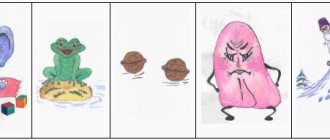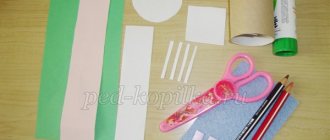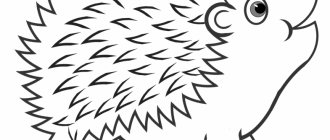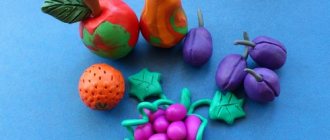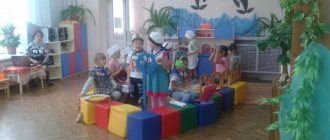Master class Methodology for composing riddles using TRIZ technology methodological development
Municipal budgetary preschool educational institution kindergarten "Golden Fish" in Tsimlyansk
___________________________________________________________________
347320 Rostov region, Tsimlyansk, st. Oktyabrskaya, 39 tel. (291) 2-49-08 INN 6137006469
Master Class
Methods for composing riddles using TRIZ technology
Educator: Boldina E.A.
2019
The purpose of the master class: to provide the opportunity to use TRIZ methods for composing riddles using reference tables using the example of the topic: “Riddles as a means of developing the speech of preschool children.”
Tasks:
— introduce the features, methodology, algorithm for composing riddles for children, forms of work;
— show with specific examples how to write riddles (electronic presentation) in work on speech development.
Practical significance: this master class may be of interest to educators and teachers who are specialists in working on the speech and intellectual development of preschool children.
During the master class, the methodology (algorithm) for composing riddles for children in different ways using reference tables will be demonstrated.
Predicted result of the master class:
- teachers get an idea of the methodology for composing riddles for children using reference tables in different ways in their work on the speech development of children:
— intensifying the introduction into the educational process of educators of methods and techniques for activating the intellectual and creative abilities of children.
Organizational moment, message of the master class topic
— Good afternoon, dear colleagues!
— I am glad to welcome you to our master class.
— One ancient Chinese proverb says: “Tell me and I will forget, show me and I will remember, let me do it and I will understand.”
— These wise words can be taken as a motto, a condition for successful work with preschool children, since it is through demonstration, observation and their own practical activity that the child develops.
“And we, preschool teachers, are creative, restless people, and in our work with children we often follow the proverb: “It’s better to see a hundred times than to hear a hundred times.” Or better yet, do it a hundred times.
— Therefore, today I would like not just to tell, but to show and give the opportunity to practically try out some of the methodological techniques that I use in my work with children on speech development.
— But before I announce the topic of today’s master class, I would like to ask you: about whom can this be said?
Educates, but is not a parent
Teaches, but is not a teacher
Studying, but not a student
Playing, but not a child. (TEACHER)
— What genre of literature do you think this text belongs to? RIDDLE. Today we will look at the methodology for composing riddles using TRIZ technology. A riddle is a means of developing the speech of preschool children.
General characteristics of the riddle
— In my work with children, I, like all educators, often use such small forms of folklore as nursery rhymes, fairy tales, counting rhymes, tongue twisters, proverbs, including riddles.
- Let's remember a little, what is a riddle?
— A riddle is one of the small forms of oral folk art, in which the most vivid, characteristic signs of objects and phenomena are given in an extremely concise, figurative form.
— Types of riddles: folk and original.
— Types of riddles:
- Descriptive, for example:
My caftan is green,
And the heart is like red
Tastes sweet like sugar
And he himself looks like a ball. (WATERMELON)
- Riddles - onomatopoeia, for example:
Behind the glass door
Someone's heart is beating.
Someone's heart is beating
So quiet
So quiet. (WATCH)
- Riddles - rhymes, for example:
In the underground, in the closet
She lives in a hole
Gray baby
Who is this? (MOUSE)
- Riddles are reversals, riddles are fables, for example:
We wound the wool into a skein
A silk scarf will come out.
Answer, is it true? (NO)
— The use of riddles is a very effective form in working on the speech development of children.
Puzzles:
- enrich children’s vocabulary due to the ambiguity of words;
- help to see the secondary meanings of words;
- form ideas about the figurative meaning of the word;
- help to master the sound and grammatical structure of Russian speech, forcing you to focus on the linguistic form and analyze it.
“But I believe that a riddle not only allows you to solve the problems of children’s speech development, but also, most importantly, brings joy to the child.
- And a riddle is a game, and the game, as we know, is the leading activity of children. A game of recognition, guessing, exposing what is hidden and concealed, what is presented in a different image, a different quality. And you don’t just need to find out, you need to guess before, from—guess.
“But when using riddles, I discovered that many children, even children of older preschool age, do not know how to solve riddles, although older preschoolers already have certain knowledge and intellectual skills sufficient to solve riddles.
— Specifically, the following problems emerged:
- listen inattentively to the text of the riddle;
- do not completely remember the content of the riddle;
-do not fully or partially understand the text of the riddle;
- when guessing and comparing, not all features present in the riddle are used;
- cannot correctly analyze, compare and generalize the features indicated in the riddle.
— Considering that a riddle is a kind of game, I decided to teach children to play riddles: not to guess them, but, on the contrary, to invent them using the well-known TRIZ methods, which I want to introduce you to today.
- So how to play riddles? Let's now try to compose riddles using the reference tables.
Methodology for composing riddles about TRIZ technology
Ι STAGE. Preliminary work: teach children to compare objects “What does it look like?”
For example: “I have a fur hat in my hands. What does it look like? (on a kitten, on a crocodile, on a snowdrift, on a bear’s den). Simply answering the question is not enough. We must prove that the hat looks like a crocodile. “Which side do you have to look from to see a crocodile? Where is his tail? What is he doing now?
STAGE II. Algorithm for composing riddles using reference tables
First model:
1. Drawing up a reference table of the form:
| "Which? (which?, which?)" | “What is it? » |
2. Selecting an object (included on the top line - for reading children, for others - a picture or a schematic drawing). For example:
SUN
3. Filling out the left side of the table: “Which?”
| "Which" | “What is it? » |
| Bright Round roast |
4. Filling out the right side of the table: “What is bright (round, hot), but not the sun?”
| "Which" | “What is it? » |
| Bright Round roast | Lamp Wheel fire |
5. Insertion of “words - connectives” - AND NOT. Making a riddle about the sun
Riddle: What is this?
Bright, not a lamp?
Round, not a wheel?
Roast, not fire?
Second model
1. Drawing up a reference table of the form:
| "What is he doing?" | “Who does the same action?” |
2. Selecting an object (included on the top line - for reading children, for others - a picture or a schematic drawing). For example:
MOSQUITO
3. Filling out the left side of the table: “What does it do?”
| "What is he doing?" | “Who does the same action?” |
| flies Squeaks Bites |
4. Filling out the right side of the table: “Who does the same action?”
| "What is he doing?" | “Who does the same action?” |
| flies Squeaks Bites | Airplane Mouse dog |
5. Insertion of “words - connectives” - AND NOT. Compose a riddle about a mosquito.
Riddle: What is it?
It flies, not an airplane?
It's squeaking and not a mouse?
It's the dog that bites, not the dog?
Third model
1. Drawing up a reference table of the form:
| “What does it look like?” | "What is the difference?" |
2. Selecting an object (included on the top line - for reading children, for others - a picture or a schematic drawing)
For example:
COMB
| “What does it look like?” | "What is the difference?" |
3. Filling out the left side of the table: “What does it look like? (on the fence, on the saw, on the grass)
COMB
| “What does it look like?” | "What is the difference?" |
| Fence Saw grass |
4. Filling out the right side of the table: “What’s different?”
COMB
| “What does it look like?” | "What is the difference?" |
| Fence Saw grass | Can't climb Doesn't saw Doesn't grow |
5. Insertion of “words - connectives” - HOW, BUT. Making a riddle about a comb
Riddle: What is this?
Like a fence, but you can't climb.
Like a saw, but doesn’t saw,
Like grass, but it doesn't grow.
Work in subgroups.
Now I invite you to become pupils and try to compose riddles using reference tables yourself in subgroups using this technique.
Words: apple, cat, car.
So, colleagues, let's see what you got. I suggest you ask the composed riddles to each other.
— Tell me, what speech problems did you solve when composing riddles? (teachers' answers).
- How can you play riddles? Various forms can be used.
Forms of working with children to write riddles:
- Compiling riddles collectively for one guesser.
One child is sent out the door. The teacher and the children select an object and discuss how to create a riddle. The object is hidden, a child is invited and one of the children asks a riddle.
- Compiling and telling riddles for children to each other in two teams or subgroups.
- Compiling house riddles using reference tables. Parents are actively involved in this work.
— So, colleagues, I suggest you exchange information:
- What were we doing with you now?
- How did we do it?
- Thus, a riddle is a real high creativity, accessible to preschool children.
Guessing and inventing riddles has an impact on the diversified development of children's speech. The use of various means of expressiveness to create a metaphorical image in a riddle (the device of personification, the use of polysemy of words, definitions, epithets, comparisons, special rhythmic organization) contributes to the formation of figurative speech in preschool children.
Analysis of the riddle helps not only to better understand and guess it faster, but also teaches children to pay attention to the word, arouses interest in figurative characteristics, helps to remember them, use them in their speech and create an accurate, vivid image themselves.
Summing up the master class, reflection.
— Returning to where we started, that is, with the motto of our master class: “Tell me and I will forget, show me and I will remember, let me do it and I will understand,” I would really like today’s information you found it interesting, useful, and most importantly, helped you in your creative work with children.
— I really like the words of E. Ermolova: “How to communicate with a child? Yes, it’s very simple: captivate until you get carried away. The richer and more multi-layered the classes are at first, the more freedom in the process and the greater talent as a result.” I wish you success and creativity in your daily work with children!
And for my further pedagogical work, I will ask you to evaluate today's master class. Reflection:
"Dear Colleagues! I ask you to evaluate the event by filling out the table using the expressions “yes”, “no”, “partially”. Thank you in advance!
| Satisfied with today's work | Gained theoretical knowledge | I can design teaching activities on this topic |
TRIZ for speech development: how to write riddles?
Why do they make and guess riddles?
Because children love to reveal secrets. It is a fact. They also love to remember what they hear and then test each other.
How do you usually get acquainted with riddles? An adult reads a new riddle to the children. As a rule, the smartest child (probably through insight) guesses what the answer is (or in more complex cases, the person who made the guess himself suggests until it dawns on someone). The rest of the children listen and remember. When the same riddle is repeated after some time to the same children, we see a “forest of hands.”
But if you dig deeper, then such “knowledge” of riddles and, accordingly, the ability to remember the desired answer is simply a memorization skill. Thinking doesn't work, and creative thinking doesn't work either. Yes Yes.
So, it is much more useful to learn to write riddles yourself.
This is not at all difficult to do, even for the little ones (with a little help from an adult).
Why? Because wonderful authors (hereinafter, three-page odes to them)) have already come up with simple and effective algorithms for this.
Simple models for writing riddles for little ones
(from T.A. Sidorchuk and A.A. Nesterenko)
Children 3-4 years old can come up with riddles based on these models.
Model 1
1. Figure out what the riddle will be about,
2. Select the main properties of this object (no more than 4),
3. For each property, select another object that has the same property.
In other words, write down the characteristics schematically, based on the table. Let our riddle be about a kitten.
Add linking words and get a riddle:
Affectionate, but not the sun,
Warm, but not a sweater,
Mustached, but not a catfish.
Model 2
Similarly, you can create simple riddles based on the actions that the object performs. It is better to take as a basis an object that can have 2-3 properties associated with movement, sound, light effects, and smells.
I'm talking about the kitten again.
The result is a riddle:
Hunts, but not a wolf,
Can jump, but not a ball,
It rumbles, but not the engine.
Model 3
Here we need to write down in the table what object our answer is similar to and how it differs from it. Once again about the kitten:
Looks like a toy, but alive,
Looks like a lion, but without a mane,
Looks like an owl, but does not fly.
There is absolutely no need to draw signs every time! It is enough to mentally imagine the desired model. And you can even combine two models in one riddle.
If you look at this way of coming up with riddles more broadly, you can use it with older students to better memorize scientific concepts from chemistry, physics, and biology. What helps with this is that in the process of composing, imaginative thinking is involved, and, therefore, memorization is more effective.
A way to write a riddle for children over 7 years old
(from A.V. Kislov and E.L. Pchelkina)
The steps of the algorithm are partly similar to those already described, but there are a little more of them:
1. Select an object; 2. Select from 1 to 3 properties of the object - visible, audible, tangible, tasteful, constant or changeable; 3. Each highlighted property is supplemented with an image that arises by association; 4. Imagine yourself in the place of the original object and describe the associated impression; 5. Select the most vivid, interesting and original descriptions from points 3 and 4, combine them into a short story or poem.
The guys and I came up with a riddle about a faulty light bulb that was blinking above our heads. Of course, I did not write down the algorithm itself word for word, but simply indicated the steps with icons. Here's how it happened.
It doesn’t matter if the riddle doesn’t add up to a poem! Prose riddles and stories are also very interesting and unusual, and most importantly, they encourage verbal creativity.
Share your original riddles in the comments!
LiveJournal
speech development
You may also be interested in: TRIZ games for preschoolers, part 1.
19 activities for creative development
Game "Yes-No": from simple to complex
TRIZ games for developing thinking, part 4
Using TRIZ in the family
The main task of TRIZ is to help people overcome the inertia of thinking - the habitual way of thinking. For example, how can you use a toothpick other than its main purpose? Psychological inertia is a force that keeps a person captive to familiar concepts. Without overcoming it, we cannot invent anything.
TRIZ also trains memory and attention, develops ingenuity, logic, and imagination. Games and tasks that can be called TRIZ captivate both children and adults. At home as a family, we ourselves can practice and develop.
For example, you can watch TRIZ cartoons (or films) in which the hero faces difficulties and solves them in an unusual way, thanks to his ingenuity and balanced approach. A classic example is the cartoon “Foka - Doc of all Trades.” The story is based on a fairy tale by Evgeny Permyak about the blacksmith Fok, who solved all the problems of Tsar Baldey.
Here are some more ways to introduce TRIZ technologies into everyday life.
